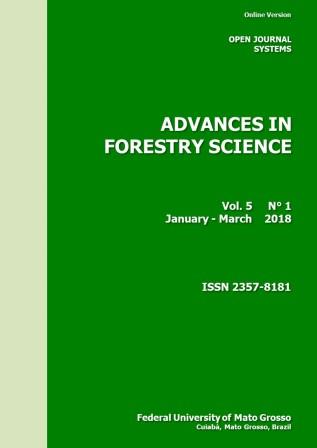Spatial stratification per district to obtain regulated forest in Brazil
DOI:
https://doi.org/10.34062/afs.v5i1.5614Keywords:
Forest planning, Linear programming, Social responsibility, Forest managementAbstract
The classic forest regulation model considers the total forest area in order to regulate production to maximize revenue. However, frequently the forest area covers more than one political or socio-economic zoning, such as a district. Taking into account the continuous operation in every one of these zones when optimizing wood harvest and revenue may result in social-economic benefits such as job maintenance and tax collection. Hence, the aim of this study was to assess a regulated forest structure model using the planted area per district as spatial stratification criterion. Three modeling scenarios were established: spatial stratification per district, annual volumetric production per district and the classic total area regulation. All models were formulated under the model 1 of linear programming. An area of 2,191 ha of eucalypt stands, from one to seven years of age, located in three districts in southeastern Brazil, was used to evaluate the proposed scenarios. The optimal solution of the proposed model met the imposed constraints (area, demand and regulation). The stratification per district, under the conditions of the present study, did not reduce net revenue, guaranteed the annual timber supply and resulted in smaller variation in the annual timber volume per district.
Downloads
References
Berger R, Timofeiczyk Junior R, Carnieri C, Lacowicz PG, Sawinski Junior J, Brasil AA (2003) Forestry transportation costs minimization using linear programming. Revista Floresta 33: 53–62.
Binoti DHB (2010). Regulatory strategies for even-aged forest with views of the landscape management. Thesis, Federal University of Viçosa. 145p.
Binoti DHB, Binoti MLMS, Leite HG, Gleriani JM, Campos JCC (2012) Regulation of even-aged forest with adjacency constraints. Forest Policy and Economics 20: 49–57.
Davis LS, Johnson KN, Bettinger P, Howard TE (200) Forest management: to sustain ecological, economic, and social values. Long Grove: Waveland Press Inc. 804p.
Falcão AO, Borges JG (2003) Heuristics for integrating strategic and operational levels in large scale forest management problems. Scientia Forestalis 63: 94–102.
Goldbarg MC, Luna HPL (2005) Otimização combinatória e programação linear: modelos e algoritmos. Elsevier, Rio de Janeiro. 518p.
Gomide LR, Arce JE, Silva ACL (2009) Using genetic algorithm in forest planning considering its selection operators. Cerne 15: 460–467.
IBÁ (2016) Annual Report of the Brazilian Tree Industry-IBÁ. Base year: 2015.
Johnson KN, Scheurman HL (1977) Techniques for prescribing optimal timber harvest and investment under different objectives: discussion and synthesis. Forest Science, Monograph 18, 31p.
Leuschner WA. Introduction to forest resource management (1984) John Wiley and Sons, New York. 298p.
Mello AA, Carnieri C, Arce JE, Sanquetta CR (2005) Forest planning for maximizing the forest revenue, taking into account the stocked carbon. Revista Cerne 11: 205–217.
Pereira GW (2009) Aplicação da técnica de recozimento simulado em problemas de planejamento florestal multiobjectivo. Dissertation, Federal University of Minas Gerais. 75p.
Rodrigues FL, Leite HG, Santos HN, Souza AL (2003) Solving forest management problems with integer constraints using tabu search. Revista Árvore 27: 701–713.
Rodrigues FL, Leite HG, Santos HN, Souza AL, Silva, G. F. (2004a). Genetic algorithm metaheuristic to solve forest planning problem with integer constraints. Revista Árvore 28: 233–245.
Rodrigues FL, Leite HG, Santos HN, Souza AL, Ribeiro CAAS (2004b). Simulated annealing metaheuristic to solve forest planning problem with integer constraints. Revista Árvore 28: 247–256.
Rodriguez LCE, Lima ABHPM (1985) A utilização da programação linear na determinação de uma estratégia ótima de reforma de um talhão florestal. IPEF 31: 47–53.
Silva GF, Leite HG, Silva ML, Rodrigues FL, SANTOS HN (2003) Problems using linear programming with a post rounding out of the optimal solution in forest regulation. Revista Árvore 27: 677–688.
Silva GF, Piassi LC, Môra R, Martins LT, Teixeira, AF, Barros Junior A (2009) A Genetic algorithm metaheuristic in the solution of forest management models (Abstract in English). Revista Brasileira de Ciências Agrárias 4: 160–166.
Downloads
Published
Issue
Section
License
All copyright must be assigned to the Federal University of Mato Grosso.

